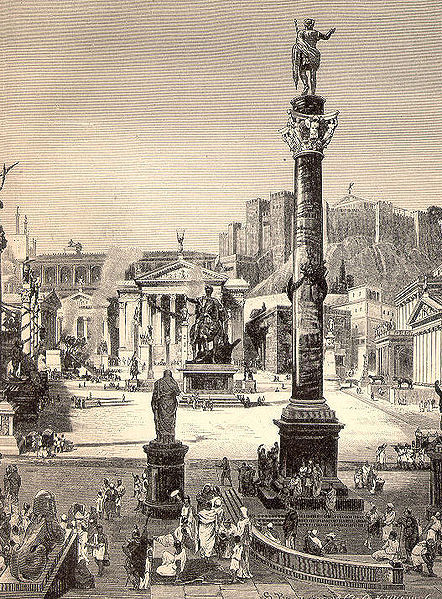
In ancient Greek society, they were often called the “companions to men.” Ancient Romans, however, viewed prostitutes as mere business transactions and called them “earners.” The lives of prostitutes were lived on the outside of ancient Roman norms. They were often slaves and it is generally believed that their lives were miserable. [SOURCE 1]

They Wore Togas
Ancient Roman male citizens wore togas while the Roman women wore the palla. Roman prostitutes were required to also wear the toga because it was associated with strong, masculine lust and sexuality. Prostitutes were viewed as having an insatiable and almost unnatural lust for sex. They had no honor and therefore they were required to wear a costume, like the lowly actors of the time, to show that they were playing their part as a sex fiend.
On the streets, wearing a toga helped separate the women prostitutes from women who were not for sale. It made it easy for men to spot them as they went about the streets of Rome, unattended, in search for a paying customer. [SOURCE 2]
They Took On New Names
To avoid bringing shame to family names, prostitutes were given new names when they were bought and placed in the prostitution trade. Like the porn stars of today, they took on names that matched their profession. Names related to Venus, the goddess of love, and names implying luck, good fortune, or pleasantries were often chosen so that men had a pretty good idea of what to expect from these women.
Many of their chosen or given names described what they were good at or their best attributes. They might even be named after legendary prostitutes. Simply put, their name was their advertisement. [SOURCE 3]
Temple Prostitutes
While some prostitutes were slaves and some were freewomen, there was a class of prostitutes who belonged to the religious temples. For instance, prostitutes who belonged to one of the many ancient Aphrodite temples were temple prostitutes. When a patron visited the temple, he would make a money offering to the goddess. In return, he would have sexual communion with a temple prostitute.
Sex with a temple prostitute was considered a sacred and religious act. It was not considered “dirty” or “wrong.” It was not adultery to commune with a temple prostitute. [SOURCE 4]
Adultery
Not so different from today, married men who visited prostitutes in ancient Rome were considered adulterers and could be penalized if caught. Of course, that didn’t stop married men from visiting houses of ill repute. They would just cover their faces when entering and leaving the buildings. No one stopped them and no one investigated the incident any further.
Ancient Greece was completely opposite. Not only were Greek prostitutes held in a higher opinion than Roman prostitutes, married men were not discouraged from visiting them. There was nothing shameful about a Greek man from visiting a prostitute, his wife probably being thankful for the break. [SOURCE 5]

Some Romans Were Forbidden From Becoming Prostitutes
Not just anyone could become a prostitute in ancient Rome. However, in an attempt to find a loophole around the laws of adultery, some bad boys of the elite decided to try and register themselves as prostitutes. When the loophole was discovered, a law was quickly passed that prohibited the senatorial and equestrian orders from becoming prostitutes.
It didn’t matter that these guys just loved having as much sex as possible. Under the new law they would have to continue to hide their faces when purchasing another body for their personal pleasure or risk being caught and charged with adultery if they were married. [SOURCE 7]
Virgins Brought Into The Trade
Sometimes virgin slaves were sold into prostitution. Other times, a virgin freewoman might be placed into prostitution as punishment for a crime. It was a big occasion when this happened. The owner of the prostitute would place laurel twigs on his door so that patrons would know that there was a virgin to be had. Much haggling ensued and a bargain would be struck to be the first patron to have her.
After the deed was done, the owner and patron would celebrate. A crown of laurels was placed on the patron’s head as a sign of conquest and he was sent out on his merry way. [SOURCE 6]
They Were Taxed
The Romans had their act together when it came to finding things to tax. Emperor Caligula pushed the taxing of prostitution back in AD 40. Prostitutes were charged at a rate of one business transaction a day. In other words, for a prostitute to survive on her own, she would need at least two customers a day. One would pay the tax and the other would give her enough for, hopefully, a piece of bread.
Men who owned male and female prostitutes would have to drum up enough business to make certain that they brought in enough clients on a daily basis to pay the tax set by the Roman rulers. [SOURCE 7]
The Barmaid
Barmaids were automatically assumed to be prostitutes in ancient Rome. There are many reasons for this. The first is that she actually was a prostitute who also worked serving men their food and drinks at the inn. The inn would often have a back room or two for the sexual side of her business.
Another reason why barmaids were classified as prostitutes is because they served men and earned their own money. Any woman who earned money in ancient Rome was considered either a prostitute or akin to a prostitute. Actors and actresses were labeled as prostitutes, as well as any other position in the entertainment business. [SOURCE 8]
Some Worked In Graveyards
While brothels seem to have been the most prolific places for prostitution, some writing has survived about the lowly prostitutes who, today, would be called streetwalkers. These women and men were known to work in the graveyards of ancient Rome. They would use the tombs as places of business, no doubt adding an extra thrill to the whole experience.
Underground burial places gave the prostitutes and their clients a bit of privacy. Those who were not fortunate enough to take a client into an underground tomb would have to use headstones and statuary as cover for their business. [SOURCE 9]
High End Prostitutes
While most prostitutes lived in grisly conditions in ancient Rome, there were a few who made it big. These high end prostitutes had their own rooms or homes. They had the right to accept or reject clients, unlike the prostitutes who were also slaves. These women were in sole control of their businesses.
Her “special” room or rooms were painted with erotic artwork to excite her clients in the same way as pornographic images are used today. These women were known to have special private parties for clients and were no doubt the talk among men in the higher social orders. [SOURCE 8]


